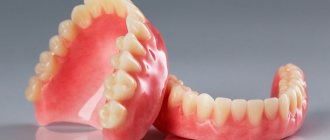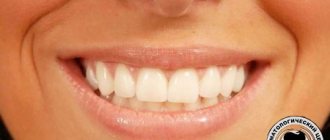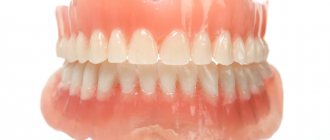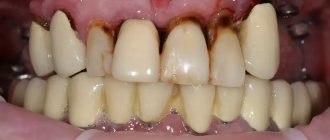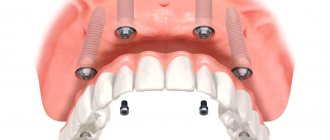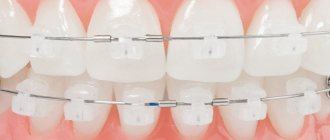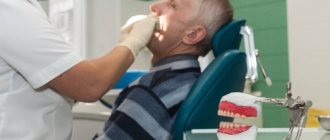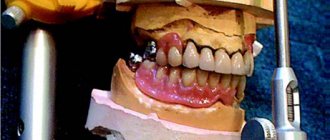With age, every person may experience partial or complete loss of teeth. Prosthetics is one of the options to solve the problem. The dentist will determine which type of prosthesis is suitable in your case - removable or fixed.
Removable structures are easy to manufacture, inexpensive (compared to other types) and outwardly indistinguishable from natural teeth. Their installation does not involve surgery.
It is important to remember that removable dentures require constant care. Otherwise, they will lose their appearance, an unpleasant odor will appear, and the surface will become a breeding ground for pathogenic bacteria.
What features do “clasps” have?
Clasp orthopedic structures have several key features and differences from other “pullers” - a metal arch at the base, a small palatal bridge and several ways to attach the prosthesis to the teeth. Let's look at these features below.
Only until December 25 South Korean implant Osstem - from 18,500 rubles.
Hurry up to sign up for a free consultation and lock in promotional prices.
Call now or request a call
Opening hours: 24 hours a day - seven days a week
Presence of a metal arc
The clasp prosthesis differs from all other removable orthopedic structures in that it has a rigid metal frame - this is the clasp or arch. It runs along the entire base, i.e. both in areas hidden by artificial gum, and in areas “free” from the gingival base - usually along a group of preserved teeth. Allows high-quality distribution of chewing pressure compared to other removable ones, therefore it is more comfortable to wear and use - it does not rub and copes with chewing food.
Features of dentures for the upper jaw
Another difference is the presence of a metal palatal bridge (for upper jaw prosthetics). It is also made of metal, but this structural element is not as massive as, for example, a plate prosthesis. In a clasp, the palatal bridge looks like a thin bridge or ring (there may be several options here), but in any case it takes up little space in the oral cavity.
Attaching the clasp structure to the teeth
Next, you need to dwell on the fastening elements of the clasp prosthesis; it can be of the following varieties - hooks (clasps), locks1 (attachments), telescopic crowns. Retainers are usually made of metal. But, for example, attachments can be partially “hidden” in the crowns or base of the prosthesis. To improve aesthetics, the upper parts of telescopic crowns are covered with light materials - ceramics, composite and others.
Types of removable dentures
The following types of removable dentures are known in dental practice:
- Clasp models. Such prostheses are made of metal, ceramics, zirconium and plastic. The support is made of metal, the body is made of plastic and other listed materials. The most important advantage of the design is that the load during chewing is distributed evenly between the jaw, gums and other teeth. Depending on the type of fixation, clasp models are: with locking fastenings, with a telescopic crown, with hook-clasps. This type of denture is used for temporary and partial absence of teeth. Clasp dentures are often used for tooth movement and periodontal disease.
- Telescopic products. These prostheses are made of metal, the top of the product is covered with acrylic or ceramics. The product is attached according to the principle of a telescope. The supporting incisors themselves are well ground. Cone-shaped systems are subsequently put on them. Secondary parts are attached to the cones.
- Immediate dentures. These devices are used when only one tooth is lost. Basically, an immediate prosthesis performs only an aesthetic function, covering free space. These devices are installed temporarily, immediately after removal or before a permanent prosthesis. The design of such prostheses has an interesting fastening, reminiscent of the shape of a butterfly.
The choice of type of prosthesis depends on several criteria:
- The first criterion: the number of missing teeth. If several teeth are missing, it is preferable to implant an implant.
- Second criterion: what final result is expected. To restore proper chewing function, it is best to use fixed dentures.
- The third criterion: how comfortable the system used should be. Removable structures must be removed at night. This fact must be taken into account.
- The fourth criterion: what financial capabilities the patient has. The most inexpensive option is removable plastic models.
Complete dentures are used if the patient is missing multiple teeth on one or both jaws at the same time. One plate compensates for the loss of all teeth at once.
If one or more teeth are missing in the dentition, partial dentures are used. They are mainly installed in cases of loss of chewing teeth and defects in the entire dentition.
What affects the wear of materials and elements
The artificial materials from which clasp dentures (and any others) are made cannot be independently renewed and restored, like natural fabrics. We are talking about the natural process of enamel remineralization (calcium saturation) or gum regeneration. Of course, you need to take care of your own teeth and gums, but also artificial ones. What many people forget about, believing that since such “teeth” cannot hurt, then there is no need to care for them. Therefore, some factors can lead to early wear of the orthopedic structure. Let's look at them in more detail:
- poor-quality care: irregular cleaning, an abundance of soft and sweet foods in the diet - combined with the lack of rinsing the mouth after such meals, refusal of professional cleaning 1-2 times a year in a clinic,
- too much force when cleaning: you can scratch the acrylic base or break the fasteners,
- incorrectly selected hygiene products: it can be either a very hard brush or a soft one - the first leaves scratches, the second cannot cope with plaque. Toothpaste with a large amount of abrasive particles also scratches the material, which reduces its service life. Dyes and pieces of food get clogged into microcracks - the material darkens, becomes dull, and may emit an unpleasant odor,
- exposure to harsh chemicals or extreme temperature changes,
- storage in an inappropriate place,
- eating very hard foods, chewing nut shells, etc.
How often should you remove the clasps?
Understanding how to properly store a clasp denture and how often it needs to be removed from the mouth, it is worth knowing that in the first days or even weeks after installation, dentists advise not to remove it at all. This is necessary for faster adaptation to the artificial structure. And those patients who followed this advice got used to the new teeth in 2-4 weeks - diction and articulation, salivation became normal, and eating became easier. But the fact that the prosthesis is constantly “stored” in the mouth does not exclude adequate care for it. Otherwise, stomatitis may occur, bad breath will appear, and in general the artificial material will take on an unaesthetic appearance due to food and bacterial plaque.
OPERATIVE PROSTHETICS WITH ACRYLIC PROSTHETICS - from RUR 180,000.
Re-prosthetics with an acrylic bridge on a metal frame (all included) up to 12 units.
Save RUR 30,000. Call now or request a call
A few words about product care
The storage of clasp dentures and the preservation of their appearance, as well as performance characteristics, are inextricably linked with proper care. What needs to be done to ensure that the clasp always looks like new and lasts for many years, we will tell you further:
- cleaning the denture 2 times a day using a special brush and paste,
- disinfection in a solution once every 7-10 days (on the recommendation of a doctor, a short soak in the solution can be carried out daily),
- high-quality cleaning of your own teeth: so that plaque and germs from them do not get onto the artificial “jaw”,
- rinsing your mouth with clean water after every meal,
- It is recommended to purchase an irrigator and an ultrasonic bath for better hygiene,
- refusal of hard products: they can leave scratches on the base or break it, damage metal fasteners, lead to “misalignment” of the arc,
- avoidance of stretchy products: they can disrupt the connection of different elements of the prosthesis,
- visits to an orthopedic dentist for preventive examinations 1-2 times a year.
It is forbidden to clean the clasp denture with highly abrasive toothpaste, with a brush with very hard bristles, or soak it in aggressive solutions - for example, in vinegar.
Own digital laboratory - speed and quality
Direct and instant interaction between the orthopedist and the dental technician allows us to reduce the time required for prosthetics and monitor the quality of workmanship at every stage.
- No possibility of distortion of transmitted data
- Bringing the prosthesis to ideal parameters without limiting the number of fittings
Which solutions are suitable for storage
Solutions - ready-made liquids or made from water and special cleaning tablets, are suitable only for caring for clasp dentures, but not for storage. Moreover, effervescent tablets are more popular, because take up less space and are more convenient to take with you. To clean the orthopedic structure, manufacturers suggest dissolving the tablet in a glass or container with clean water at room temperature. Then you should place the prosthesis in a container and leave it for 3 to 15 minutes (each brand has its own operating time). Then the “clasp” is removed, cleaned with a brush, washed in running water and dried. After these manipulations, you can install it on the jaw, but the solution must be poured out.
Popular brands of cleansing tablets are Corega, PresiDENT, Protefix, ROCS BONY plus Express, LACALUT DENT Reinigungs Tabs.
Computer diagnostics - for reliable data
Allows you to choose the right type and method of fixation of the prosthesis. The Center uses a Sirona Galileos tomograph (Germany).
- Assessment of bone tissue at the site of lost teeth
- Analysis of the condition of abutment teeth
- Study of the anatomical features of the dentofacial apparatus
Features of storage of the clasp design
How to store a partial denture outside the mouth, for example, at night or during dental treatment? Ideally, you will not remove it from your mouth at all. But if removal is necessary, it is better to have a special container on hand. Such containers are made specifically for storing removable dentures. Inside the container there may be a holder curved in the shape of a jaw - so that the product does not move inside and does not scratch the walls.
Read on the topic: a container for storing removable dentures - what it can be and which one is better to choose.
After removal, the “clasp” must be cleaned and rinsed with water, gently wiped with a clean napkin and stored in a container. In the same container you can soak in the cleaning solution (if the instructions for the container do not prohibit this). For example, the container can be “double-layered” - with a mesh immersed in the container, and also equipped with an ultrasonic cleaner. For long-term storage, containers with ventilation holes are suitable so that excess moisture can evaporate without problems and not settle inside.
“I stored my bugel in a regular food container. Well, I screwed the lid tightly. Then I realized that I shouldn’t have done this, because... an unpleasant odor appeared. I decided not to close the lid, but I became afraid that someone would sweep the container off the table and the “jaw” would break. Then I decided not to suffer and buy a special case.”
Olga Sergeevna, review from otzovik.com
It is important to place the container with the clasp denture in a suitable place - a shelf in a closet or bedside table is quite suitable. There should be no sources of heat or moisture nearby - a radiator, stove, water tap or humidifier. It is better not to leave the prosthetic structure in the bright sun, because... the material may become discolored. Another danger is posed by sharp objects, unstable massive structures - a hanging shelf with knives, a stack of books, a vase with a bouquet of flowers, etc. Place container behind closed doors, out of reach of small children or pets.
1Gromov O.V. “Lock fastenings in clasp prosthetics, 2010.
Your questions and answers
QUESTION Hello, I’ve been wearing a clasp denture for 2 weeks now, but I still don’t understand how to store it? I put it in water overnight a couple of times, but then I stopped. I don’t remember what the doctor said about this... Evgenia
ANSWER Hello, Evgenia. In general, you don’t even have to remove your clasp denture for now and “store” it directly in your mouth. Because the main task in the first weeks is to get used to the artificial structure. And the more time it “spends” in your mouth, the faster you will get used to it. As for storing clasp dentures in water, absolutely all orthopedic dentists do not advise leaving modern dentures for a long time in any liquid. Maximum – 15-30 minutes a day. Excessive moisture can damage the material, and your prosthesis will quickly become unusable and you will have to make a new one.
Author: Dulgarov Zh. G. (Thank you for your help in writing the article and the information provided)


